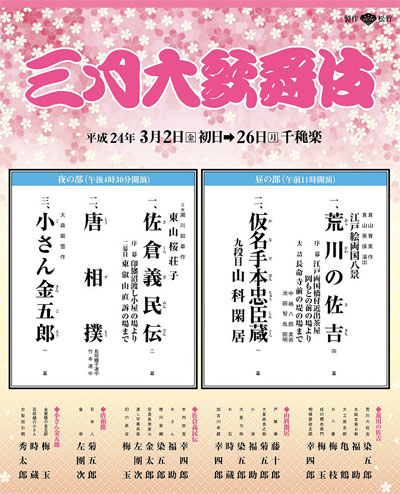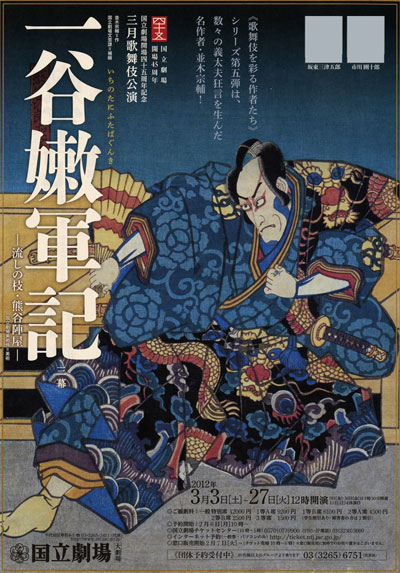| MARCH 2012 |
|
5 shows in T˘ky˘ (Shinbashi Enbuj˘, National Theatre, Heisei Nakamuraza) and 2 shows in Ky˘to (Minamiza)!
|
| Shinbashi Enbuj˘ (T˘ky˘) |
| Dates | 2 ~ 26 March 2012 (Sangatsu ďkabuki) March Grand Kabuki |
| MatinÚe | |
| Evening |
Kosan Kingor˘ |
| Casting |
Onoe Kikugor˘, Sakata T˘jűr˘, Nakamura Tokiz˘, Matsumoto K˘shir˘, Nakamura Baigyoku, Nakamura Fukusuke, Kataoka Hidetar˘, Ichikawa Sadanji, Ichikawa Somegor˘, Ichikawa Danz˘, Band˘ Hikosabur˘, ďtani Tomoemon, Matsumoto Kingo, Kawarasaki Gonjűr˘, Ichimura Manjir˘, Nakamura Utae, Nakamura Kikaku, Ichikawa Komaz˘, Band˘ Kamesabur˘, Band˘ Kametoshi, Nakamura Matsue, Onoe Matsuya, Sawamura S˘nosuke, Onoe Ukon, Nakamura Baishi, Matsumoto Kintar˘, ďtani Hirotar˘, ďtani Hiromatsu, Nakamura Mantar˘ |
| Comments |
|
 |
| National Theatre (T˘ky˘) |
| Dates | 3 ~ 27 March 2012 |
| Program |
|
| Casting |
Ichikawa Danjűr˘, Band˘ Mitsugor˘, Nakamura Kaishun, Band˘ Yajűr˘, Nakamura T˘z˘, Kataoka Ichiz˘, Ichimura Kakitsu, Ichikawa Monnosuke, Band˘ Shűch˘, Band˘ Minosuke |
| Comments |
|
 |
| Heisei Nakamuraza (T˘ky˘) | |
| Dates | 3 ~ 27 March 2012 (Sangatsu ďkabuki) March Grand Kabuki |
| MatinÚe |
Kiichi H˘gen Sanryaku no Maki
|
| Evening |
Keisei Hangonk˘ (Domo Mata) |
| Casting |
Nakamura Kanzabur˘, Kataoka Nizaemon, Kataoka Gat˘, Nakamura Senjaku, Nakamura Kankur˘, Ichikawa Ebiz˘, Nakamura Shichinosuke, Nakamura Tsurumatsu, Nakamura Kotar˘, Kataoka Sennosuke, Nakamura Toranosuke, Nakamura Muneo, Nakamura Kunio, Sasano Takashi |
| Comments |
The Heisei Nakamuraza is back in T˘ky˘ in the popular district of Asakusa. This time, it is a 7-month project (performances up to May 2012!) for this temporary theater built within the Sumida Park. This month is special as the new Nakamura Kankur˘, the heir of the Nakamuraya guild, will celebrate his shűmei at the family theater!
|
|
|||
| Dates | 3 ~ 27 March 2012 (Shűzan Matsuri Sangatsu ďkabuki) Shűzan's Festival March Grand Kabuki |
||
| MatinÚe | |||
| Evening | |||
| Casting |
Nakamura Kichiemon, Nakamura Kanjaku, Nakamura Matagor˘, Nakamura Kash˘, Nakamura Shibajaku, Kataoka Ainosuke, Nakamura Kinnosuke, Nakamura Karoku, Nakamura Kazutar˘, Sawamura Yoshijir˘, ďtani Keiz˘, Nakamura Hayato, Nakamura Yonekichi, Nakamura Tanenosuke, Nakamura Kichinosuke |
||
| Comments |
Nakamura Matagor˘ III and his son Nakamura Kash˘ IV celebrate their shűmei in Ky˘to! This is also the first Shűzan's Festival outside T˘ky˘, which commemorates the memory of Nakamura Kichiemon's grandfather Nakamura Kichiemon I!
|
||
|
|
| Contact | Main | Top | Updates | Actors | Plays | Playwrights | Programs | Links | FAQ | Glossary | Chronology | Illustrations | Prints | Characters | Derivatives | Theaters | Coming soon | News |